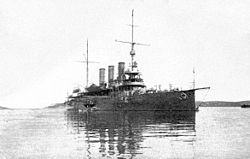SMS Sankt Georg
|
SMS Sankt Georg
|
||||||||||||||||||
|
||||||||||||||||||
|
||||||||||||||||||
|
||||||||||||||||||
|
||||||||||||||||||
SMS Sankt Georg was an armored cruiser of the Austro-Hungarian Navy , which was a more heavily armed variant of the cruiser SMS Kaiser Karl VI. was planned. The ship made several trips abroad, was then used in the First World War and played a key role in the sailors' uprising in February 1918. After the war, the ship was scrapped. The cruiser was named after Saint George .
history
Building history
In response to the three Varese-class armored cruisers built by Italy in the years 1898–1902 , the Austrian and Hungarian Diets approved the funds for the construction of a third armored cruiser for the already existing Emperor Charles VI in 1900 . and Empress and Queen Maria Theresa . The keel was laid on March 11, 1901 in the naval arsenal Pola . It was launched on February 8, 1903, commissioned on July 31, 1905. In accordance with the customs of the time, the ship had a large number of guns of various calibers.
Peace and war missions
- 1905 - the ship and the Szigetvár participated in the operation of the international emergency fleet in the Levant .
- 1906 - Levante cruise
- 1907 - Together with the Aspern to the USA to visit the 300th anniversary of Jamestown / Virginia
- 1913 - Patrols off the Montenegrin coast on the occasion of the Balkan War
- August 7, 1914 - Departs with the entire fleet to escort the German warships SMS Goeben and SMS Breslau to Pola. Cancellation of the mission, Saint George returns at Cape Blanca.
- May 23, 1915 - Use of the entire kuk fleet against the Italian east coast. Bombardment of Rimini by St. George .
- June 18, 1915 - In association with the Szigetvár bombardment of Rimini, Persaro and Metauro.
- February 3, 1916 - In association with the Heligoland bombardment of St. Vito and Ortona .
- 28/29 August 1916 - Participation in the naval advance off the Italian east coast
- May 15, 1917 - The ship's formation with the Sankt Georg expires in support of the Novara group, which is engaged in naval combat in the Strait of Otranto .
Sailors' revolt
Under the impression of a very poor supply situation, which was mainly evident in malnutrition , and inspired by the communist February and October revolutions in Russia in 1917, the sailors of St. George decided to start an uprising in the port of Cattaro (Kotor) . On February 1, 1918 at 12 noon, 30 armed sailors took over the ship and shot down the general officer (first officer). The commandant was also shot, but the bullet missed him. A red flag was hoisted and shots were fired. Other crews in the port began to take over ships for their part. The uprising quickly expanded among large-crewed ships, but did not affect all smaller ships. The German submarines and ships in the port did not join the uprising either. A subsequently convened council of sailors made a list of demands. The hope of receiving broad support via radio reports about the uprising and the demands everywhere in Austria-Hungary and especially at the Pola naval base was not fulfilled because u. a. the telegraph operators tampered with the equipment. The army units on land and the warships that had remained loyal, led by the cruiser Helgoland , surrounded the rebels after three days and prevented them from escaping from the port. After an ultimatum, the mutineers finally gave up.
The entire crew of the Sankt Georg was taken off board and the ship was disarmed, decommissioned and anchored as a barge in Téodo .
The ringleaders Franz Rasch and Anton Grabar, the sailor Jerko Sizgoric, who was accused of having shot down the overall detail officer of the Sankt Georg , and the sailor Mate Brnicevic of the Gäa were subsequently sentenced to death and executed.
In January 1920 the Allied Naval Commission in Paris awarded the ship to Great Britain, which sold it to an Italian company in Taranto for scrapping .
Technical specifications
Armor protection
- Belt armor: 165 to 210 mm
- Deck: 36 - 45 - 60 mm
- Armored bulkheads: 190 mm
- Front barbette: 210 mm
- Front tower: 50 - 160 - 200 mm
- Gun casemates: 150 mm
- Command tower: 125 to 200 mm
Note: For the sake of authenticity, the place names are given in the spelling of the Imperial and Royal Navy. The links refer to today's conditions.
literature
- Erwin S. Sieche: The cruisers of the k. and k. Navy (= naval arsenal with international naval news and naval overview 27). Podzun-Pallas et al., Wölfersheim-Berstadt et al. 1994, ISBN 3-7909-0506-2 .
Web links
Individual evidence
- ^ A b Paul, G. Halpern: The Cattaro Mutiny, 1918. In: Christopher, M. Bell / Bruce A. Elleman (ed.): Naval mutinies of the twentieth century. An international perspective. London 2003, ISBN 0203584503 , pp. 54-79.


